
Finding Your Flock: An Interview with the Storks Writer/Director and Cast
From the L.A. Screenwriter collection.
Nick Stoller might have the most range of any writer in Hollywood. He is able to seamlessly move from writing lewd romps like Get Him to the Greek and Sex Tape to the friendliest family affair like The Muppets. Having launched his career by directing Forgetting Sarah Marshall, Stoller has established himself as one of the most diverse talents in the business. His new film, Storks, showcases his ability to draw in audiences of all ages.
L.A. Screenwriter’s John Bucher had a chance to sit down with Stoller and the cast of Storks—Andy Samberg, Kelsey Grammer, and Stephen Kramer Glickman—to talk about the project.
John Bucher: I wasn’t quite sure how I would feel about Storks because I like a lot of your other work that is more adult, but to be honest with you, I was really amazed at the substance of the film and really enjoyed it.
Nicholas Stoller: Thanks so much. Great.
John Bucher: The film starts with the mythological aspect of storks bringing babies. Can you talk a little bit about the origin of the idea?
Nicholas Stoller: All the movies I’ve directed are really close to me emotionally, and this is like that. My first child was really easy for my wife and I to have, but our second was really … It was very hard, and we ended up having a lot of fertility treatments. It made me really appreciate my first child in a way I hadn’t. So, the idea popped into my head that the world of storks used to deliver babies now deliver Amazon products. That’s the comedy premise, but the emotional component of it is buried. It all started with the struggles that my wife and I went through to have our second kid. It’s a love letter to parenthood and family.
John Bucher: Was there any symbolism in some of the character names, like Tulip for example? That’s not exactly a typical name that you would give a child in this age.
Nicholas Stoller: Yeah. That was my daughter. I asked what should be the main character name? She said Tulip. I liked that. I probably should have thought more about it, but didn’t.
John Bucher: Can you talk a little bit about the development of the characters from your mind to the page to the voice to then the animation? It seems to me by the time they end up on screen, you have these really juicy, well-developed, thought-out characters. Do they start that way?
Nicholas Stoller: It took a long time, but first I wrote the script which had the big macro moves. But then it changed a lot. There was this idea early on that I wanted to be like Raising Arizona, where every character meets the baby and falls in love with the baby and wants to keep the baby. But we ended up losing that. Then, we cast a lot of comedy talent as scratch. Katie Crown was one of those people. We ended up casting her in the film because her performance was so good. I workshopped the scenes in the recording booth with the scratch actors before we cast the film, and we turned to improv. We threw out the script and just kept the intention of the scenes, and then the team would do storyboards and animate off of that.
John Bucher: What were the themes or the messages in the material that Nick wrote that really drew you to this script?
Kelsey Grammer: For me, just celebrating babies, celebrating life, celebrating the gift that every child is.
Andy Samberg: I always say, “You’ve got to find your flock.” When I asked Nick what the movie was about, he said “Well, it’s about finding your flock.” I knew then we were on the same page.
Stephen Kramer Glickman: I felt from the start that it was just a solid film about people finding their family, and also finding where they belong in the world. I think it’s done so beautifully. I was a little choked up at the end, but like in a good, heartwarming way, not in a soul-crushing sad way.
John Bucher: Kelsey, your character, Hunter, can go so far to the dark side with the vocal intonations. Yet you find a moderation in there where you can be menacing and still playful. How do you find that resonant level for creating the character?
Kelsey Grammer: John Gielgud once said, “Style is knowing what play you’re in.” Now, that may or may not help you. It was a question that I always had—how do you do that? You have to know you’re in a comedy. You have to know that you are actually allowing the audience to participate on some level. When you go dark and mean it, then you don’t let them in. In this performance, there’s always something funny going on.
John Bucher: Stephen, how did you find the voice for this character, because it’s really unique?
Stephen Kramer Glickman: It was partly based on my old roommate in Long Beach. There’s also a little bit of Walter Cronkite in there. Also, there was a kid that grew up near me in San Diego and every time he said anything, at the end of the sentence he would end it with this weird inflection. When I saw the drawing of Pigeon Toady, I was like, “Oh, this is what he sounds like.”
John Bucher: Nick, do you want to do another animated film?
Nicholas Stoller: Oh, I’d love to, yeah. It was a great experience.
*Feature Image: Storks / Warner Bros (2016)